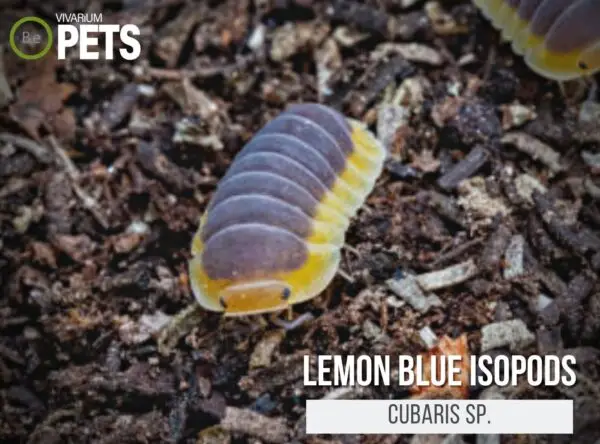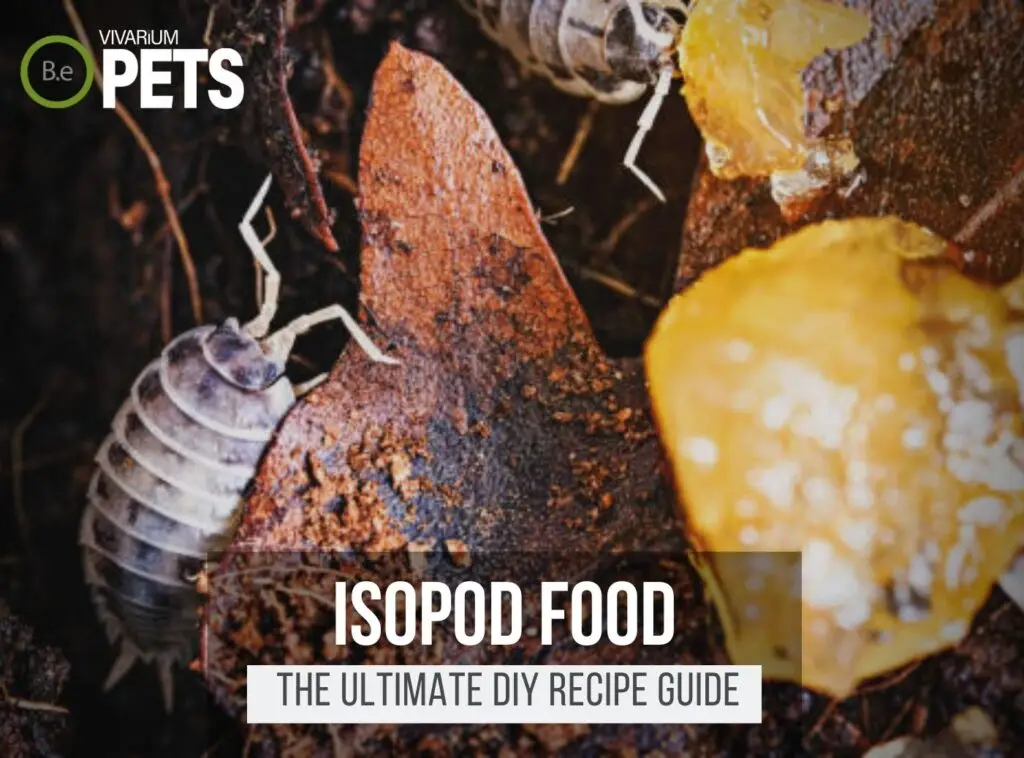Are you looking for an eye-catching critter to add to your terrarium? Look no further than the stunning Lemon Blue Isopod!
These amazing invertebrates are gorgeous lemon and blue cubaris isopods that will bring life to any terrarium. Not only are they visually stunning but they are also incredibly easy to care for.
In this article, I’ll discuss their natural habitat, care requirements, their unique appearance, and answer some of the most popular questions about these fascinating creatures. So, let’s find out more about Lemon Blue Isopods!
| Characteristics: | |
|---|---|
| Common Name | Lemon Blue Isopods |
| Family Name | Armadillidae |
| Scientific Name | Cubaris sp. 'Lemon Blue' |
| Use | Cleaning, Aerating Soil, Feeders |
| Temperament | Non-aggressive |
| Lifespan | 1-2 Years |
| Diet | Detritivore |
| Adult Size | 1-2 cm |
| Breeding Type | Egg Layer |
| Care Level | Easy |
| Minimum Tank Size | 5-10 Gallons |
| pH | 5.5-7.5 |
| Hardness | Moderate |
| Temperature | 75-81°F |
Table Of Contents:
ToggleWhat Are Lemon Blue Isopods?
Lemon Blue Isopods are small, colorful crustaceans in the family Armadillidae and the genus Cubaris. This small species is often referred to as the ‘Lemon Blue Dwarf Isopod’ and its scientific name is Cubaris sp. ‘Lemon Blue’.
Native to regions of Thailand, these isopods thrive in a humid, hot climate, with plenty of organic material to feed on.
The name ‘Lemon Blue’ comes from their distinct coloration which is a mix of lemon yellow and powdery blue. The older the isopod, the brighter the yellow will be.
What Do Lemon Blue Isopods Look Like?
Lemon Blue Isopods are small crustaceans that measure about 0.6 inches in length. They have a round, oval-shaped body that is typically lemon yellow in color and covered with an array of blue spots.
The yellow color of the body and the bright blue spots are the namesakes of these isopods… earning them their common name “Lemon Blue”.
An eye-catching feature of these isopods is the pair of black marks they have on their anterior end. The eyes are more visible in Lemon Blue Isopods compared to other isopod species.
They have seven pairs of walking legs, which have short spikes and are covered in bristles. The outer segments of the legs have pads that can contribute to the isopod’s grip.
They also have two pairs of antennae, which are slightly shorter than the legs. The Lemon Blue Isopods have a hard exoskeleton, which allows them to survive in adverse conditions.
Benefits Of Using Lemon Blue Isopods
Lemon Blue Isopods are an excellent addition to terrariums and paludariums due to their helpful roles in the environment.
These isopods are efficient organic matter decomposers, breaking down dead plant matter and acting as janitors in the enclosure. They are also beneficial to live plants, as they will help aerate and enrich the terrarium soil.
This species is also great for algae control, eating algae as well as other types of debris. Lemon Blue Isopods reproduce quickly and are relatively easy to maintain, so they are an ideal choice for vivarium owners.


Lemon Blue Isopods Facts
Lemon Blue Isopods are small colorful crustaceans in the genus Cubaris, with a mild temperament and a lifespan of 1-2 years.
They are detrivores, needing a varied diet of organic matter, and decaying wood, with the addition of calcium-rich foods like eggshells.
They breed in warm months with temperatures of 24-27°C and high humidity.
Habitat
The natural habitat of the Lemon Blue Isopod is primarily tropical and humid regions, such as Thailand or China. These areas are characterized by a rocky substrate and are commonly bushy or vegetated.
Many of the areas these isopods populate have high humidity and temperatures nearing 30 °C. These moist environments provide plenty of food sources and suitable living conditions for the isopods.
The Lemon Blue Isopods are nocturnal animals, meaning they are most active at night. They prefer to stay hidden beneath moist soil and bark during the day and come out to feed at the night.
They are also able to survive in a variety of environmental conditions and tend to prefer a temperature between 24 to 30 degrees Celsius and a humidity level of 65 to 70%.
Diet
In their natural habitat, Lemon Blue Isopods will feed on decaying plant material, detritus, rotting wood, and other decaying matter.
As a detritivore, they are adapted to breaking down this organic matter to provide your terrarium with the natural benefits of this process.
A diet rich in decaying leaves, grass, twigs, bark, and other garden debris will help to make sure they stay healthy and active.
Temperament
Lemon Blue Isopods are generally not a species that people interact with as they are small and solitary creatures.
However, they are not aggressive and are not a danger to other animals or humans. They are a docile species and will usually hide away when disturbed.
These isopods like to live in damp, dark places and prefer to stay away from bright, open spaces. They are mostly solitary and will not interact with each other. They are slow-moving and primarily scavenge for food.
When kept in a terrarium, Lemon Blue Isopods will often explore their environment during the evening when the lights have been switched off.
Lifespan
Lemon Blue Isopods have a short lifespan of up to 2 years in ideal conditions. In a well-maintained terrarium, these isopods can stay healthy and active which will help them reach their maximum lifespan.
The life cycle of a Lemon Blue Isopod begins with its eggs hatching after 2 to 4 weeks of incubation. After hatching, they will reach sexual maturity within 8 to 10 weeks.
During this period, they will molt repeatedly until they reach their adult form. After this, they will mate, with the female laying eggs for the next generation.
Breeding
Lemon Blue Isopods reproduce by direct mating where two isopods join together for a few minutes to copulate.
During mating, the female Lemon Blue Isopod will attach a pleopod to the male’s gonopod.
After the process is completed, the females will then typically bury their eggs in the substrate to protect them while they develop and hatch.
The eggs will hatch in 1-2 weeks depending on the temperature.
Once the Lemon Blue Isopods have hatched, they will go through several stages of development called instars until they reach maturity.
Depending on the temperature, the time it takes for the isopods to reach adulthood can range from 4 to 8 weeks.
Once the Lemon Blue Isopods reach adulthood, they will be able to reproduce. Mating is seasonally determined and is typically higher during the warmer months of the year.
The isopods will generally mate for several months every year and can produce multiple broods of eggs every year.
Where To Find Lemon Blue Isopods
Finding Lemon Blue Isopods can sometimes be a challenge, and they are not available to purchase in many pet stores.
They are found in their native habitats in Thailand, but it can be difficult to access these areas. Luckily, there are some more accessible locations where you can purchase Lemon Blue Isopods.
If you are looking to catch your own Lemon Blue Isopods, the best way to do this is to search for moss, rotting logs, or rocks in moist or wet areas.
Isopods tend to be most active in the early morning or late evenings, so try searching during these times. You can also collect from other sources such as water parks, public swimming pools, and ponds.
If you are successful and collect your Lemon Blue Isopods, remember to be sure that you do not introduce non-native species, as this can have a damaging effect on the local environment.
Lemon Blue Isopods Care
When caring for Lemon Blue Isopods, it is important to provide them with the correct temperature and humidity, as well as a substrate that is full of organic material for them to feed on.
Make sure to stay consistent with their water needs, and provide them with a varied diet.
To ensure their health and well-being, it is important to monitor the environment and make sure it is clean and free from aggressive predators.
Tank Requirements
When caring for Lemon Blue Isopods, it is important to keep their tank setup in mind. For the best environment, a moist tropical terrarium with a top layer of live terrarium moss is ideal.
Maintaining a temperature between 68-84 degrees Fahrenheit and a humidity of around 75% is also helpful for these isopods.
Additionally, an open-air environment with minimal terrarium lighting is best, though adding in a few low-wattage bulbs can provide some helpful shadows and temperature change.
The substrate should be soil and leaf litter, which is perfect for creating small burrows. A moderate pH of 6.0-7.0 is also preferred.
What Do Lemon Blue Isopods Eat?
In captivity, Lemon Blue Isopods should be offered commercially available preparations such as dried fruit and vegetable flakes, freeze-dried bloodworms, frozen shrimp, and other commercial reptile and amphibian diets.
Additionally, they can be provided with small amounts of fruits, vegetables, bread, or grains. It is important to avoid greasy or sugary foods, as these can be destructive to their sensitive systems.
They should also be dusted with a calcium supplement periodically, to allow them to get the nutrients that they need.
If you’re more of an avid hobbyist like myself, be sure to check out my ultimate DIY Isopod food guide. I give a more in-depth explanation of the best foods and my personal favorite recipe.
Best Tankmates For Lemon Blue Isopods
When choosing tankmates for Lemon Blue Isopods, it is best to stick with small invertebrates that are easy to maintain and won’t compete with the isopods for food.
Popular tank mates include springtails, small snails, small roaches, and some shrimp. For example, Malaysian Trumpet Snails (MTS) are great for adding beneficial bacteria to the tank and helping to aerate the substrate.
They are laid-back, peaceful creatures, and will not compete with the Lemon Blue Isopods for food, making them a great addition.
Conclusion
Lemon Blue Isopods are an amazing species that can bring life to any terrarium. They are relatively easy to care for and have a unique blue and yellow coloration.
If you’re looking for a new critter to add to your enclosure, then these gorgeous invertebrates might be the perfect option. With the right care and maintenance, they can be a great addition to any paludarium or terrarium.
Frequently Asked Questions
The size of an adult lemon blue isopod is approximately 2cm.

